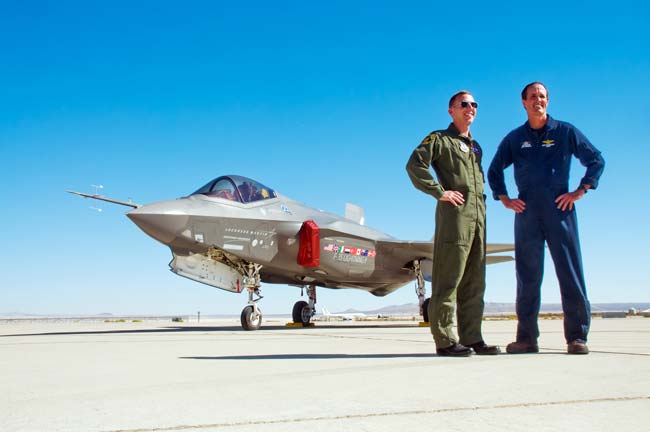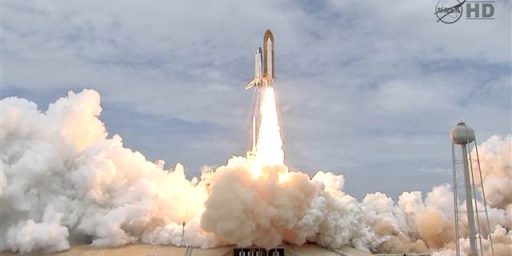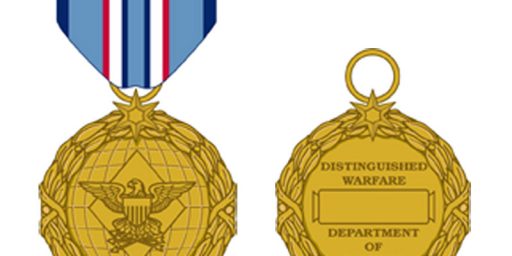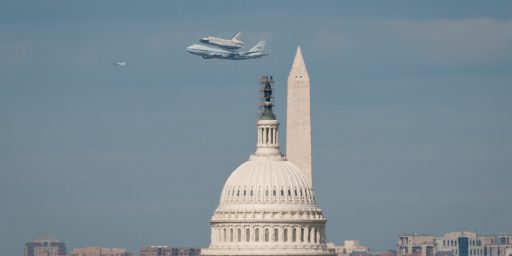No More Manned Fighter Jets?
 Robert Farley cites testimony by SECDEF Bob Gates and JCS Chair Mike Mullen wherein they don’t dismiss entirely the idea that the F-35 Joint Strike Fighter might be the last manned fighter the U.S. military ever builds. He thinks this a logical evolution:
Robert Farley cites testimony by SECDEF Bob Gates and JCS Chair Mike Mullen wherein they don’t dismiss entirely the idea that the F-35 Joint Strike Fighter might be the last manned fighter the U.S. military ever builds. He thinks this a logical evolution:
[T]here are currently jobs that manned warplanes can do that drones can’t perform (human pilots are more visually capable than even the best drones, for example), but a) drones are getting better, b) drones are so much cheaper, and c)taking the pilot out means that you can do a lot of funky, interesting things with an advanced airframe. This isn’t to say that the F-35 (or even the F-22) have no role; they’ll continue to be useful frames for the jobs they’re intended to do for a substantial period of time. But I don’t think there’s a next “next generation” of fighter aircraft. And in any case, it appears that the A-10 will remain the platform of choice for fighting the giant robots that undoubtedly will afflict us in the future…
David Axe notes that the aircraft companies and the Russians might have something to say about that and several of Matt Yglesias‘ commenters point out that the cultural affinity of the military, particularly the Air Force, for manned fighters will be hard to overcome. One, Campesino, observes that the Navy is already working on an unmanned carrier bomber.
I don’t claim much expertise on weapons technology but unmanned fighters are scientifically inevitable. We’re already pushing the envelope on what human pilots can sustain. Designing planes around human beings means making them larger, more expensive, and less capable of doing their job than they could already be now. Human physiology is unlikely to evolve as fast as aerospace technology. (As an aside, we’ll continue to need human piloted transport planes, I think, because the need for human judgment is more critical and the need for speed and maneuver is diminished.)
I do, however, have some expertise on the impact of military culture on force planning, having written my dissertation on the subject. The late Carl Builder outlined the basics twenty years ago in his masterwork The Masks Of War: American Military Styles In Strategy And Analysis. The essence of the book is that each of the military services has a core vision of itself that remains constant even as technology and the operational environment change. While the Navy has had fighter planes just as long as the Air Force (indeed, longer than we’ve had an independent Air Force), it merely sees airplanes as one tool in maintaining American dominance of the seas. The Air Force, by contrast, exists only because of its “toys” and its pilots think of themselves first and foremost as drivers of a particular aircraft.
The combination of the pilot mafia, lobbyists for aircraft manufacturers, and powerful sympathizers in the halls of Congress will make it very difficult to make the technologically logical move here.






As an ex-USAF non-rated (not a pilot) officer, I agree. What will happen is that somebody else (China? Russia? Israel?) will do it first and we’ll act like it’s a shock that something like that can happen. And then we’ll declare an “unmanned fighter gap” and throw lots of money at Boeing, Lockheed, etc., to correct the problem.
It seems to me that this development constitutes one more argument in favor of abolishing the Air Force as an independent branch.
This is why Bob Gates has been hellbent on bringing the USAF’s civilian and military leadership under control and killing the F-22 program. They’re still running a guerrilla campaign with Congressional supporters to do an end-run around Gates. This kind of crap must stop, or Gates better be prepared to fire some people on the Air Staff.
Oh, and a timely discussion of the F-22 in today’s WaPo.
I’d like to point out that there is a world of difference between “The F-35 will be our last manned fighter” and “We are going to stop using manned fighters”.
Since the F-35 can already exceed the human body’s thresholds, there isn’t much to be gained by designing a new fighter. More likely the F-35 platform will be gradually improved with new technology as it becomes available, but the platform itself will not need to be replaced.
Ever?
We are already using drones for combat mission. Here is my prediction of what will happen. We will develop drones further and many will say the man fighter is obsolete. Then a country will find a way to jam the signals to the drones making them ineffective and easy targets. Then they will try putting sophisticated computer and programs on the drones which will be costly and not all that effective. In the end their will be a combination of the two depending on where and who the fight is against. Then the arms race will continue.
See The Right Stuff for the successful fight the first astronauts put up to be able to “fly” the reentry vehicles. No “Spam in the Can” for those guys.
So you are saying that there is no such thing as an Air Force mission set? Whatever happened to Close Air Support, Interdiction, Recon, Strategic Bombing, Air Superiority, Rescue, Transport, Strategic Missile Attack, and lots more? Yes, there are “toys”, but they have been designed for a mission or set of missions.
It is entirely immaterial that pilots think of themselves as drivers of a particular aircraft, because they are directed to perform missions suited to their aircraft, weapons and training(usually!)by a higher command.
Because of Air Force culture, many of those are dramatically underserved. Even though it’s been clear since the early 1990s that transport and CAS are key USAF missions, the brass has successfully fought allocating more resources there at the cost of the cool toys like fighters and bombers.
Speaking as a former SAC Trained Killer missileer, I’ll tell you in all seriousness that leg of the triad has been dying a slow death since the early 90s when the fighter jock mafia under then Gen Merrill “Tony (no crew neck T-shirts)” McPeak took over as CSAF. The USAF is all F-22, all the time, as far as acquisition priorities are concerned.
Some missions are suited to drones as we have seen in Iraq and Afghanistan, and some are not, or not yet, anyway. My point is that the Air Force is driven by the mission concept no less than the Navy, and their multiple mission capabilities are rather essential to our combat forces.
Thus, to integrate the Air Force back into the Army, for instance, does not make sense. All one would be doing is to change the color of the uniforms and the chain of command, but not the mission set!
We have had the usual attempts to combine procurements for naval air and the air force, and it ends up with significant variants per service every time. The F-35 has three, is it? There is, I agree, considerable commonality of airframe parts, but I would think that the avionics and some weapons would very all over the place.
We already have a form of multi-service integration in the Strategic area, by way of the SIOP, which tailors the strategic forces missions appropriately, which illustrates the way forces can be fought today in the era of far better communications. The integrated battlefield approach is another multi-service capability being evolved.
Tanker operations is a complex undertaking in support of air missions. Neither the Army nor the Navy has the number of personnel, the training,the experience or the equipment to execute the large scope refueling operations that the Air Force does regularly and well. Current combat fighters and strike aircraft can require at least two, or sometimes even three, tanker visits per mission.
The point is that Service culture impacts choices on force structuring, training, manning, procurement, etc. If the Army were in charge of fixed wing aircraft, we’d have more transport, more close air support, more SAR, and fewer cool fighter jets.
That’s apples and oranges. Operational planning is the responsibility of the combatant commanders. In your example, the SIOP mission resides at the Strategic Command. Interestingly enough, their last commander was a Marine (now VCJCS Cartwright). The services are responsible for training and equipping the force. This is what’s so important about USAF acquisition priorities. The move in 2003 to go away from the old MNS/ORD based acquisition system to the capabilities based JCIDS system currently used means that a program like the F-22 can be justified even if there is no comparable threat to it.
My understanding is that Warthog drivers are held in lower regard than fighter drivers in the USAF. (But I can tell ya, in the shit, I rather have two A-10s around that five F-15s.)
A-10 drivers are a special breed. I went to Squadron Officer School with one of them, and he was more like an Army guy than AF. He lived and breathed flying slow and low. He also flew OV-10s, and was a forward air controller. Yeah, he wasn’t one of the glamour boys in the fighter mafia pecking order.
The tradeoffs do not favor lots of F-22s, but rather “just enough” to keep the lines open and the mods coming for a few years, so that ramp-up can take place rapidly if needed.
We need those aircraft, pilots, and weapons that have proved to be effective in current combat roles, including a number of drones. I liked the idea of the “super A-10” rework that I understand is going on, but the number of airframes is not large. Not a priority for the fighter jocks, for sure, but very effective in Iraq.
But even the A-10 type of manned CAS A/C is easily defeated by modern multiple-sensor-channel gun and missile systems now on the market. The drone might look very good indeed in a variation of that role. As I may have stated before here, my former company had built by 1990 over 80 30mm GAU-8 based missile defense systems that could reliably hit 120mm shells in flight twice in succession.
An A-10 is a huge target for that system, as was shown to the USAF at Red Flag one year: A-10 pilots, on seeing the tape of the tracker with lead angle disconnected having the crosshairs quite steadily on their cockpit through all of their best maneuvers, were suddenly palefaced.
I curious, what do some of you more knowledgeable folks think about the danger of the technology driving the mission rather than the mission driving the technology?
Really? My point was that the Air Force is mission-oriented: it has a mission in SIOP, and it has a mission on the battlefield, among other missions.
Of course the commanders call the shots. There is a rather wide gap between what the commanders want to fight with and what they are getting now from the procurement side, in my opinion.
And as recent deficiencies associated with Air Force’s handling of the nuclear surety mission attests, the USAF has been greatly neglecting that critical SIOP mission through the gradual relaxation of standards and tranining, something which would never have been tolerated in the days of SAC. Curtis LeMay must have been rolling in his grave. They’re now playing catch up with the removal of missile forces from AF Space Command and into the new Global Strike Command.
It cracks me up when people get into the “this is the best system\branch†or “this system\branch is obsoletesâ€. The truth is we need good balance of systems and braches and that balance will change depending on conflict. We should be careful not to get too fix on any current conflict resulting in getting too far off of having an overall balance system.
Air superiority is a major concern. Any system has counter system. The tank was said to make the Infantry obsolete. It ended up not even being able to take on the infantry alone. However combine with infantry it is a great combat multiplier.
Because of the AF brass concentration on getting all the F-22s they want, this in itself is a good reason to put the AF under the Army? I shudder to think of the transition period, which would probably take years to smooth out. Meanwhile, seems to be one of Gate’s key problems.
We just might have a restart of the Chyanne!
I notice nobody has adequately addressed Wayne’s point about the possibility that the electronic systems forming the link between UAVs and their remote controllers might be jammed. At that point, manned aircraft would be incredibly useful …
Certainly true. But presumably a system could jam the avionics on a human-driven aircraft. And we’re going to have a full fleet of human-driven fighters as a backup in case the drones go down?
Modern, pseudo-random, digital, frequency-jumping communications systems are extremely resistant to jamming, and since they can exist in C, L, S and X bands where the enemy operates radar, to jam a whole band is for him largely to deny himself the band–which can be exploited quickly. So, the link from mothership to drone can be strongly secure using diverse and rapidly-changing frequencies (pulse by pulse), coupled with highly directional, multi-element antennas.
Drones are also fitted with auto pilots which allow them to “coast through” periods of effective jamming or heavy noise, and be reaquired by the mothership later on, when the S/N ratio for the link recovers.
Lacking recovery, the autopilot can fly the drone to any designated point within its range, and land it, or else destroy it on a target or in the air. This is true for the Predator, for instance.
I believe the same holds for satellite-drone digital links as well.
Finally, it would be hard to jam the internal avionics of either a drone or a manned plane. Comm and radar receivers can be hit, but under most circumstances that doesn’t affect other electronics on board. Many times, however, the receivers merely shut down, and reopen when the high noise levels drop down.
For one currently deployed version of the comm systems I referred to, Google JTIDS (Link 16).
I guess that DC loser has not been privy to any earlier SAC booboo reports, some of which were hair-raisers.
Manning – If you’re refering to the loss of nuclear weapons in the 50s and 60s, then it’s apples and oranges again. Those were because of the then policy of flying aircraft on airborne alert with nuclear weapons. That policy was overturned as a result of aircraft accidents. I’m not aware of SAC loss of nuclear weapons as a result of accounting procedures or such lack of discipline. Nuclear surety was not an afterthought in those days, but the central tenet of the organization.
No, I wasn’t referring to the 50s and 60s. Never was apples and oranges either.
Pray tell, please enlighten us all with the details…
DC Loser, you know that is not on, and you know the several whys of it. Or, if you don’t know the whys, that is simply too damn bad.
Please….I have more tickets than you will ever have. And Broken Arrow, Bent Spear incidents are pretty much public knowledge. Don’t put it out there if you can’t bring it up in this forum.
Well, DCL, I have had quite a large number of tickets too, especially in the Community. But, as to beating you, I have no idea, and it isn’t very important.
In the past, I have “roamed” just about every AF, Army, and Navy development center, command centers and major intel shops there are, including the Pentagon, Omaha, the Springs, NATO, the UK, Germany and most other fine places here in the East. Except one–the White House. I was tired of living in vaults and SCIFs, too.
Been in most aircraft shops, on projects, sometimes as PM or CSE, including Boeing, Lockheed, Northrup-Grumman and earlier, Douglas, and quite a few subsystem suppliers, such as Itek and GE, and maybe 30 others.
I made my point, carefully: it was simply the place to stop.
Been there, done that, didn’t buy the T-shirt.
I would have, but got sent South rather abruptly thinking I’d get to visit Cuba. Neither happened–so I got another Florida T-Shirt instead!